In her interview with us (see Judith Lasater on Yoga and Aging), Judith Lasater mentioned the poses that she currently practices, citing "especially Viparita Karanai (Legs Up the Wall pose), Supported Sarvangasana (Shoulderstand) on the chair and Supported Halasana (Plow pose) on the Halasana bench." In my post Judith Lasater's Favorite Poses, I talked about these poses and why, even though they may be a little tricky to learn, they're so worth the effort. On Monday, I described Supported Halasana in detail. Today, at last, I'm going to tackle Chair Shoulderstand! To be honest, when you first learn how to do this pose, it is one of the most challenging to get in and out of. So I normally teach people how to do Chair Shoulderstand in person. But I think it's worth having the instructions and photographs showing the process for those of you who may have seen a demonstration once and forgotten the steps, as well as for any brave souls who are willing just to give it a try.
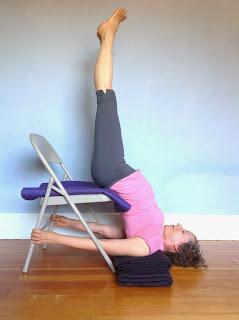
Full Chair Shoulderstand (My Happy Place)
I certainly encourage you to try Chair Shoulderstand and, if you like it, to add it to your home practice because this variation of Shoulderstand will allow you experience the legendary "soothing" quality of Shoulderstand. Because you are completely inverted in this pose, the relaxation response will take effect quite quickly (see Why You Should Love Your Baroreceptors). Your neck is also flexed in the pose, which enhance the relaxation (see More Love for Baroreceptors). And you can use the supported version of Shoulderstand in place of full Shoulderstand in any sequence (or class) that includes full Shoulderstand.Instructions: To do this pose, you just need a sturdy chair with four legs. It's okay if the chair has a bar between the front legs or a back panel.
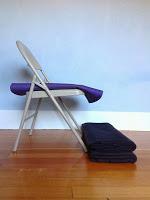
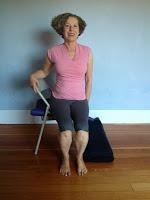
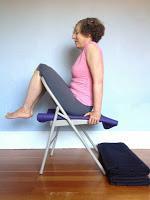
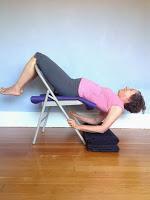


Congratulations you've made it into a Chair Shoulderstand! If you're comfortable, stay in the pose for several minutes, as long or longer than you would in full Shoulderstand. I like to stay at least six minutes because after five minutes something magical happens, as I can actually feel my body and mind switch into relaxation mode. However, if the pose is uncomfortable or causes you any pain, come out of it. Think about what kind of changes you might make to your propping, such as adding another blanket under your shoulders (for example, if your neck feels uncomfortable) or on top of the chair seat (if your pelvis isn't well supported). Unlike Supported Halasana, Chair Shoulderstand is a pose in which most everyone can find a way to get comfortable, so it's worth taking your time to figure out the best way for you to do it. If you can't make it work on your own, consider asking your teacher to look at you in the pose and make some suggestions.
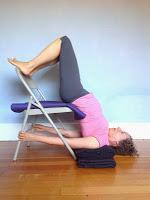
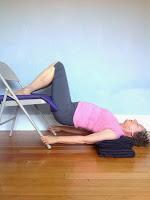
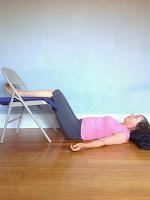
11. Finally, roll over onto your side and rest there for a couple of breaths. When you're ready, slowly use your hands to push yourself up to a seated position, only raising your head when you are fully upright. Taking your time coming out of the pose helps you retain the quietness you cultivated while you were in the pose.

